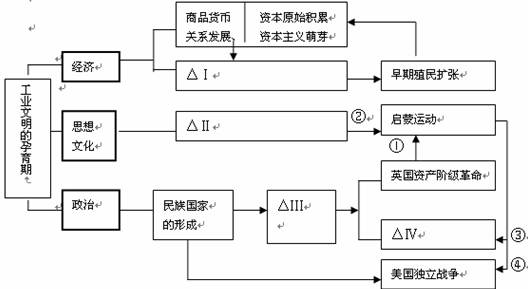问题
综合题
阅读《工业文明孕育期社会变革示意图》,完成各项要求:(12分)

(1)根据图中经济、思想文化、政治的要素分类,在带△的方框内填写适当的历史事件。(4分)
(2)在图中找到与启蒙运动相关的四个箭头,对箭头的含义做出合适的解释。(6分)示例:箭头①:启蒙思想产生于英国,英国资产阶级革命是启蒙思想产生的时代背景之一。
箭头②:
箭头③:
箭头④:
(3)如果要表示人类正式进入工业文明时代,应该在本示意图的右面添加一项什么重大历史事件?(2分)
答案
(1)△Ⅰ:新航路开辟;△Ⅱ:文艺复兴:△Ⅲ:君主专制的建立;△Ⅳ:法国大革命。(4分)
(2)箭头②:启蒙运动是继文艺复兴之后,欧洲新一轮的资产阶级思想解放运动。文艺复兴为启蒙运动奠定思想基础;箭头③:启蒙运动为法国大革命提供理论根据,进行舆论动员;箭头④:启蒙运动为美国独立战争提供理论根据,进行舆论动员,并为独立后的美国提供政体构想。(6分)
(3)工业革命。(2分)
